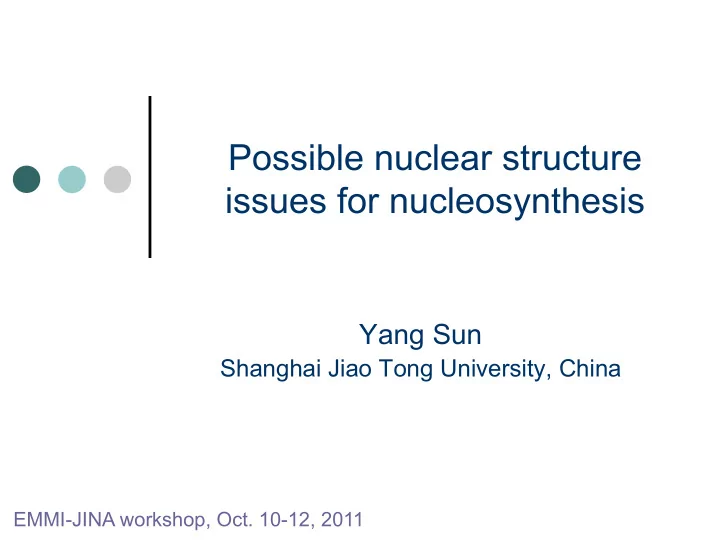

Possible nuclear structure issues for nucleosynthesis Yang Sun Shanghai Jiao Tong University, China EMMI-JINA workshop, Oct. 10-12, 2011
Major scientific facilities in China HIRFL-CSR, Lanzhou LAMOST, Xinglong Observatory near Beijing Heavy Ion Res Facility + Cooling Storage Ring Multi-Object Fiber Spectroscopic Telescope SSRF, Shanghai CSNS, Dongwan of Guangdong Province Shanghai Synchrotron Radiation Facility Chinese Spallation Neutron Source
HIRFL-CSR: Beam facilities
CSRe: Cooling storage ring 36 Ar → RIB RIBLL2 + CSRe Isochronous mass spectrometer 78 Kr → RIB • End of 2007: test run • End of 2008: 1st physics run • Fall of 2009: results
How much the tiny nuclear structure changes can influence the nucleosynthesis results?
Mass measurement results ¢ Masses of these nuclei are measured for the first time. ¢ Current HIRFL-CSR results have similar error bars as CDE predictions. ¢ It confirms that CDE method is reliable at least for 63 Ge, 67 Se. ¢ It shows some differences for 65 As and particularly for 71 Kr.
Coulomb displacement energy (CDE) Difference in binding energy of mirror nuclei Binding energy of the proton-rich nucleus Binding energy of the neutron-rich nucleus D(A,T) calculated with Skyrme Hartreee-Fock method
吸积盘
Important factors for a nuclear structure model calculation ¢ Single particle states (mean field part) l Reflect shell structure (spherical, deformed) l Adjust to experiment ¢ Two-body interactions (residual part) l Mix configurations (do not have in mean field models) l Transition probabilities are sensitive test ¢ Model space (configurations) l Large enough to cover important parts of physics l If not possible, introduce effective parameters
Ongoing projects ¢ Two shell model studies l Projected shell model (for well-deformed nuclei) l Large-scale spherical shell model (for near-spherical nuclei) ¢ Structures of neutron-rich nuclei l r-process interests ¢ Structures of proton-rich nuclei near the N=Z line l rp-process interests ¢ Structure of heavy, stable nuclei l s-process interests
Energy spectrum for 55 Fe: A projected shell model calculation ¢ Projected shell model calculation for 55 Fe energy levels
Spherical shell model with core- excitations ¢ Magic nature of 132 Sn has recently been confirmed by Jones et al. Nature 465 (2010) 454. ¢ Spectroscopy of valence nuclei with one particle in empty shells or one hole in completely filled shells provides direct information on single-particle structure. ¢ Spectroscopy of nuclei with two particles or two holes provides information on correlations between different kinds of pairs.
Shell model calculation considering particle-hole excitations show features supporting magnetic rotation bands.
Question of shape effect In some nuclei, different shapes are known to co- exist near ground state. Nuclear shape coexistence leads to shape isomeric states (excited states having relatively long lifetimes).
Nuclear isomers ¢ Bethe (1956): “An excited nuclear state which endures long enough to have a directly measurable lifetime is called an isomeric state.” ¢ Isomeric states occur because, to match the states to which it decays, it is difficult for a nucleus l to change its shape (shape isomer) l to change its spin (spin trap isomer) l to change its spin orientation relative to an axis of symmetry ( K -isomer) Walker and Dracoulis, Nature 399 (1999) 35 ¢ These states may behave like new nuclei in the reaction network.
Energies levels of 68 Se and 72 Kr Bouchez et al , PRL (2003)
Isomer influence on abundances in X-ray burst ¢ It is possible that a flow towards higher mass through the isomer branch can occur (calculations using multi-mass- zone x-ray burst model) l Y. Sun, J. Fisker, M. Wiescher, et al ., Nucl. Phys. A758 (2005) 765 Without any possible isomer contribution Full flow through isomers rather than g.s.
β -decay & electron-capture in stars ¢ Stellar weak-interaction rates are important for resolving astrophysical problems l for nucleosynthesis calculations l for core collapse supernova modeling ¢ Calculation of transition matrix element l essentially a nuclear structure problem l necessary to connect thermally excited parent states with many daughter states l for both allowed and forbidden GT transitions
Stellar enhancement of decay rate ¢ A stellar enhancement can result from the thermal population of excited states ⎛ ⎞ ⎜ ⎟ p ∑ ∑ λ = × λ i ij β β ⎜ ⎟ i j ⎝ ⎠ ( ) ( ) 2 I 1 exp E / kT + × − i i p = i ( 2 I 1 ) exp ( E / kT ) ∑ + × − m m m ¢ Examples in the s-process F. Kaeppeler, Prog. Part. Nucl. Phys. 43 (1999) 419
B(GT) and log ft in 164 Ho à 164 Dy Z.-C. Gao, Y. Sun, Y.-S. Chen, PRC 74 (2006) 054303
Nuclear matrix elements (future) ¢ To calculate quantities relevant to reactions, realistic many-body wave functions are needed. ﹤ A+1,I’ | a + | A,I ﹥ , ﹤ A+2,I’ | a + a + | A,I ﹥ ¢ Preferably the wave functions are eigenstates of angular momentum and particle number, contain sufficient structure information in initial and final states. ¢ To perform shell model calculations and obtain the wave functions, one needs good l single-particle states l effective interactions l algorithms to construct shell model configurations
Summary ¢ Tiny nuclear structure changes may influence nucleosynthesis results l Example in nuclear mass calculations l Example with nuclear shape isomer ¢ Reliable shell model calculations for decay and nucleon- capture rates are needed l Workable models for any size of nuclei, deformed or spherical l Spectrum description is a crucial test for those models ¢ Particular nuclear structure changes may be more interesting l Deformation effect l Sudden changes in shell structure l Nuclear isomers
Recommend
More recommend